INTRODUCTION
Heart disease and stroke are among the highest causes of death in the world. Stroke, heart failure, and kidney disease are the main risk factors for hypertension. Therefore, hypertension is a health problem considered one of the most dangerous in the world (DiPiro et al., 2015; Virani et al., 2020). Hypertension is a condition in which the blood pressure in the arteries increases persistently. The normal blood pressure is 120/80 mmHg; moreover, a person is deemed hypertensive if the systolic blood pressure is ≥130 mmHg and the diastolic blood pressure is ≥80 mmHg (Riley et al., 2018; Whelton et al., 2018).
According to several studies, the percentage of hypertension prevalence among the population aged ≥18 years diagnosed by doctors was 8.4% in Indonesia in 2018; this was 1% lower than the percentage in 2013. The prevalence of female hypertension was greater (36.9%) than that of male hypertension (31.3%) (Depkes, 2018). In 2019, hypertension was a noncommunicable disease that ranked first in Yogyakarta. In 2020, there were frequent cases of hypertension in the regency of Sleman, Yogyakarta, amounting to 138,702 cases. It was such an increase since there were 82,592 cases in the previous year (Depkes, 2019, 2020).
The American Heart Association has recorded that the number of people with hypertension in the United States aged over 20 years has amounted to over 74.5 million people (Benjamin et al., 2019; Virani et al., 2020). Indirectly, hypertension may affect the heart’s condition due to several changes in the blood vessels, such as atherosclerosis. Atherosclerosis may result in cardiovascular disease and increase the risk of an ischemic incidence, such as angina and myocardial infarction (Tackling and Borhade, 2021). Hypertension may also negatively impact the heart directly due to the pressure effect of hypertension. The pressure effect of hypertension leads to left ventricular hypertrophy, which eventually becomes myocardial, thus making no arterial changes. A cardiac compensatory method is known as left ventricular hypertrophy in response to an increased resistance caused by increased blood pressure. Hypertrophy is a risk factor for coronary heart disease (Lalande and Johnson, 2008; Suhadi et al., 2016).
There are two divisions of factors affecting one’s quality of life. The sociodemographic factors such as gender, age, race, education, employment, and marital status. The medical aspect factors include long-lived hemodialysis, the disease stages, and the operational medical observational arrangements (Louzado et al., 2021).
Age is one of the factors affecting one’s quality of life. It is also one of the risk factors for cardiovascular disease (Aghamolaei et al., 2011). One’s declining quality of life often occurs when one becomes older. Reduced quality of life includes several aspects such as public health, physical function, physical role, social function, vitality, pain, and mental health. Moreover, gender plays an essential role in one’s quality of life; men tend to have a better quality of life than women (Lee et al., 2020). Educational background may also serve as a factor affecting one’s quality of life. If someone has an excellent academic background, they tend to adapt to an unfavorable situation better. Therefore, educational background positively impacts one’s quality of life (Aghamolaei et al., 2011; Louzado et al., 2021).
When viewing the sufferer based on their job, previous researchers found out that a sufferer with a lower socioeconomic condition would have a higher anxiety level than someone in a higher socioeconomic situation (Alegría et al., 2018; Brook and Schmidt, 2008). That was how one’s job affected one’s quality of life. Moreover, some habits may affect one’s health, such as the consumption of a poor diet of high calories, high fats, and high salt, lack of workout activities, and smoking (Gorski and Roberto, 2015). Poor diet is one of the factors in coronary heart disease. One should monitor their physical activity habits and smoking habits (Buttar et al., 2005). Moreover, they need to consume more vegetables and fruit. One’s quality of life can also be observed through healthcare, either preventive or medication. The excellent service aspect may increase the sufferer’s satisfaction and quality of life.
Another research revealed that marital status played an essential role in the sufferer’s quality of life. An unmarried person, a widow, or a widower had lower quality of life than a married person. Moreover, the sufferers in a later stage are more likely to feel the effects of their disease. They had a lower degree of health condition since they suffered various complications of their diseases. Both the infection and ferocity limited their activities and caused them to depend on medication. Eventually, that would affect the overall inner aspects of their quality of life (Carr et al., 2001).
According to the psychometric property assessment results of the health-related quality of life instrument in the general population, we can employ an SF-12 instrument as one of the categories of instruments assessed as an established instrument (Haris et al., 2019). One’s quality of life is measured physically, mentally, cognitively, and socially since it is the ultimate goal of a chronic illness treatment intervention. It is crucial for a hypertensive person to have a good quality of life in order that they will be able to treat their disease. Hence, in this study, we aim to determine the relationship between the factors of demography, comorbidity, medication, lifestyle, and access to health services related to the quality of life of people with hypertension and its complications.
Here, we report that the factors that affected the quality of life of hypertension patients in Sleman, Yogyakarta, in the physical strain category were the gender variable, age, diagnosis of hypertension and its complications, page-disease, fatty foods consumption, and drug consumption in the last 2 weeks, whereas the factors that affected the mental component were education and occupation. Furthermore, the quality of life with hypertension and its complications influence and decreases the patient’s physical more than mental condition.
MATERIALS AND METHODS
This study employed secondary data on the Health and Demographic Surveillance System (HDSS) in Sleman in the 2015–2018 period. The used data were the demographic data of individuals (their gender, age, marital status, education, and work), their comorbidities [stroke, pneumonia, diabetes mellitus (DM), and angina], their lifestyle factors (fatty foods and smoking), and their medical factors (old medicine for the past 2 weeks and the past 12 months). Moreover, their access to health services (the place for treatment and payment) served as an independent factor, while dependency was the quality of life using the SF-12 v2 (Kim et al., 2014) with slight modification. The sampling was retrieved using purposive sampling, as shown in Figure 1.
Under the population of the longitudinal Sleman HDSS surveillance research, hypertension was recorded. The complications were made into a sample in the study of 532 respondents meeting the inclusion criteria (aged >25 years and lack of disability). Then, the respondents were to fill out the complete questionnaire. In contrast, the incomplete data from the respondents were excluded from this study. In terms of the aspects of quality of life measured in this study, they were divided into two components and made up of eight domains, as shown in Table 1.
The data analysis was carried out using Statistical Package for the Social Sciences software version 21 (IBM Corporation, Armonk, NY) and using statistical methods with the number, percentage, Mann-Whitney test, and Kruskal-Wallis test for multivariate analysis.
RESULTS
Based on the research results conducted by taking the data from the HDSS of Sleman, Yogyakarta, from December 2020 to June 2021, there were 1,093 patients with hypertension and its complications. However, when the data were filtered, a sample of 532 respondents meeting the inclusion criteria was obtained.
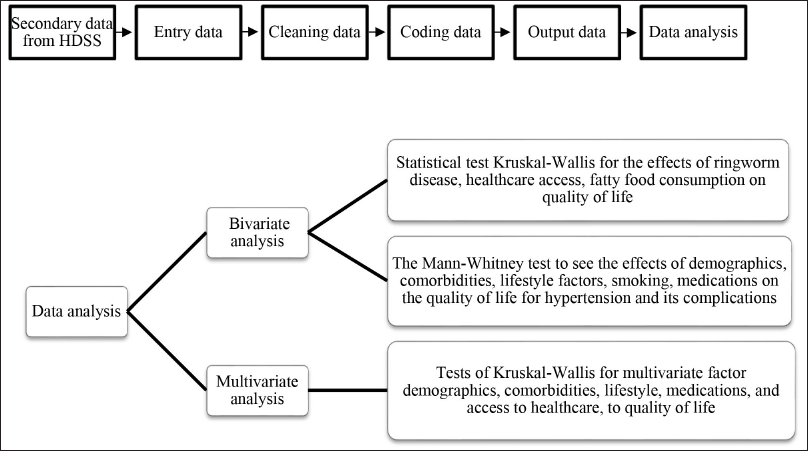 | Figure 1. Scheme for secondary data retrieval, phases of data processing, and stages of analysis. [Click here to view] |
 | Table 1. Summary of the Short Form 12v2 instruments with two components. [Click here to view] |
The distribution of the respondents with hypertension based on gender was dominated by female patients amounting to 336 patients or accounting for 36.8% (Table 2). Meanwhile, the number of male patients was 196, accounting for 36.8%. Moreover, most of the patients with hypertension and its complications were over 45 years old, with 383 (72%) married patients, 464 patients without university degrees which meant that they accounted for the majority, and 383 (72%) patients with jobs. Taking into account the respondents’ lifestyles in this study, in general, they did not smoke. However, they still consumed a lot of fatty foods. Moreover, based on the kinds of treatment for the past 12 weeks, 244 respondents took the medication, meaning that fewer than half of the respondents took the pills for a short period, while more respondents took the drugs for the past 12 months. Based on the respondents’ access to any health services, many respondents chose to go to public hospitals (or community health centers), amounting to 159 respondents (29.9%), and to health worker practices amounting to 187 respondents (35.2%) to receive medical treatment. As for the payment method of their medical treatment, many respondents used insurance. However, few of them paid in cash.
The descriptive text could be observed in the distribution of the respondents with hypertension and its complications. Figure 2 showed that, of 532 respondents, 342 (64.3%) suffered from hypertension. Therefore, these statistics indicated that hypertension affected the occurrence of other complications. There were 43 (8.1%) respondents with hypertension + angina. There were 73 (13.7%) respondents with hypertension-caused angina and hypertension + stroke. Moreover, uncontrolled hypertension resulted in a high incidence of stroke [24 (4.5%) respondents], angina [39 (7.3%) respondents], and stroke + angina [8 (1.5%) respondents]. Thus, hypertension triggered other complications.
More respondents had a history of single hypertension than those with hypertension and its complications such as stroke and angina, as shown in Figure 3. More respondents were suffering from hypertension with stroke. Based on the data on comorbidities in hypertension and its complications, it was found that 38 respondents suffered from hypertension with DM. However, most of the respondents did not have comorbidities.
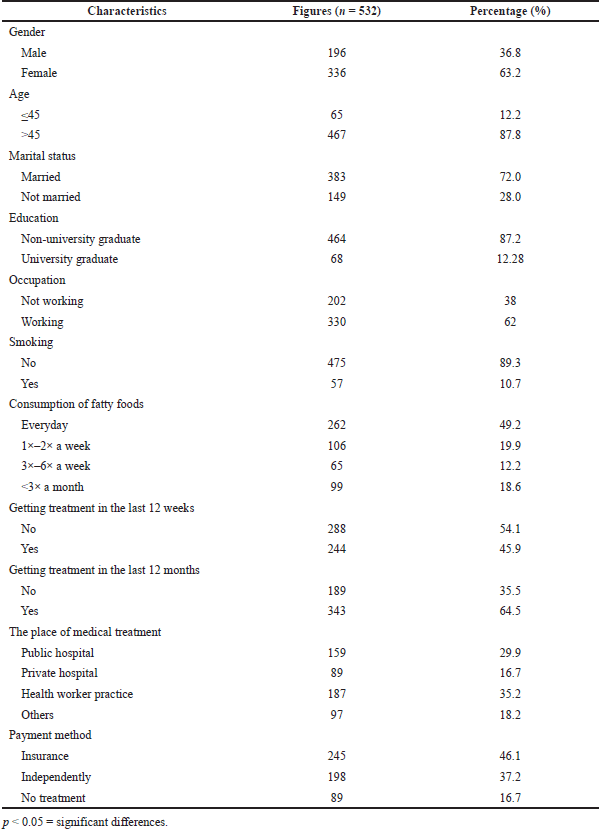 | Table 2. Characteristics of demography, lifestyle, and access to health services of people with hypertension and its complications in Sleman, Yogyakarta. [Click here to view] |
The factors related to physical components as shown in Table 3 were the variable of gender with p value = 0.011, age with p value = 0.006, diagnosis of hypertension and its complications with p value = 0.000, comorbidities with p value = 0.002, consumption of fatty foods with p value = 0.048, and medical treatment for the past 2 weeks with p value = 0.001. Meanwhile, the factors related to the mental component were the occupation variable with p = 0.006 and the education variable with p = 0.004, observed from the p value < 0.05.
DISCUSSION
Based on the distribution of the characteristics of the respondents’ gender, it was found that most of the respondents were women. Many women suffer from hypertension due to their hormones. Women experience menopause, and this increases the risk of high blood pressure (Wenger et al., 2018). Female estrogen serves to increase high-density lipoprotein (HDL) (Demarin et al., 2010). However, when a woman enters the menopause period, the production of this hormone will significantly decrease. Low HDL cholesterol levels and high levels of LDL (Low Density Lipoprotein) cholesterol lead to atherosclerosis, which increases blood pressure (Sagita et al., 2019; Vergeer et al., 2010).
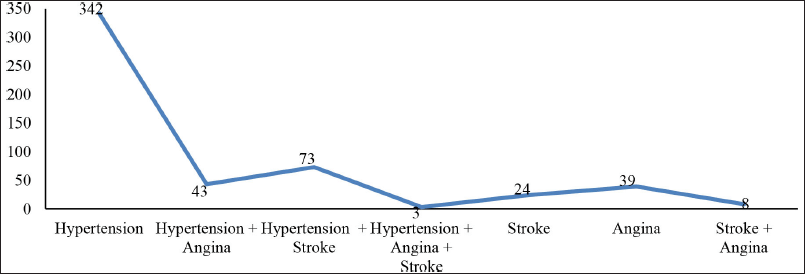 | Figure 2. Patients with hypertension and its complications: clinical characteristics and complications. [Click here to view] |
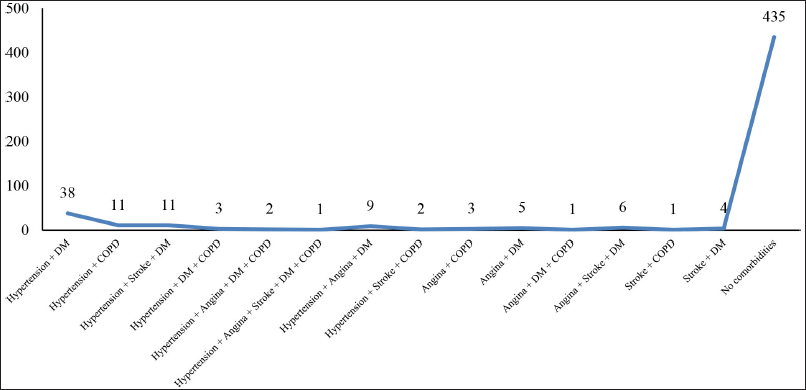 | Figure 3. Patients with hypertension and its complications have a variety of comorbidities that have distinct clinical characteristics. [Click here to view] |
Age affects the summary of physical components. Generally, hypertension occurs in over-40-year-old people. An over-40-year-old person allows a physiological change (Buford, 2016). The walls of their blood vessels lose their elasticity. The dilation of the blood vessels and the continuous pumping of the blood cause increased blood pressure. If that situation continuously occurs, it will affect one’s life quality, especially in physical activities (Amanda and Martini, 2018; Wagenseil et al., 2009).
Hypertension and its complications and comorbidities also affect the physical components (Petrie et al., 2018). However, that result was not in line by the previous study conducted by Perwitasari et al. (2018). The comorbidity, p = 0.045, showed a significant relation to the MCS scores but not PCS scores. Moreover, the results of this study were comparable to that of the previous research conducted by Khoirunnisa and Akhmad (2019), where the complication factor did not show a significant relation to the PCS scores; however, it showed a significant relation to the MCS scores where the p value = 0.001. The results of their study were by that of this study which significantly affected the MCS scores. The quality of life in all domains of patients diagnosed with hypertension with stroke was significantly worse than in those with hypertension alone. The presence of other chronic diseases limited the patient’s physical activity and more drugs taken by the patient, resulting in more possibility of the side effects of the drugs might affect the patient’s quality of life and patient’s compliance. Any symptoms of hypertension and cardiovascular diseases will greatly impact the quality of life especially physical health.
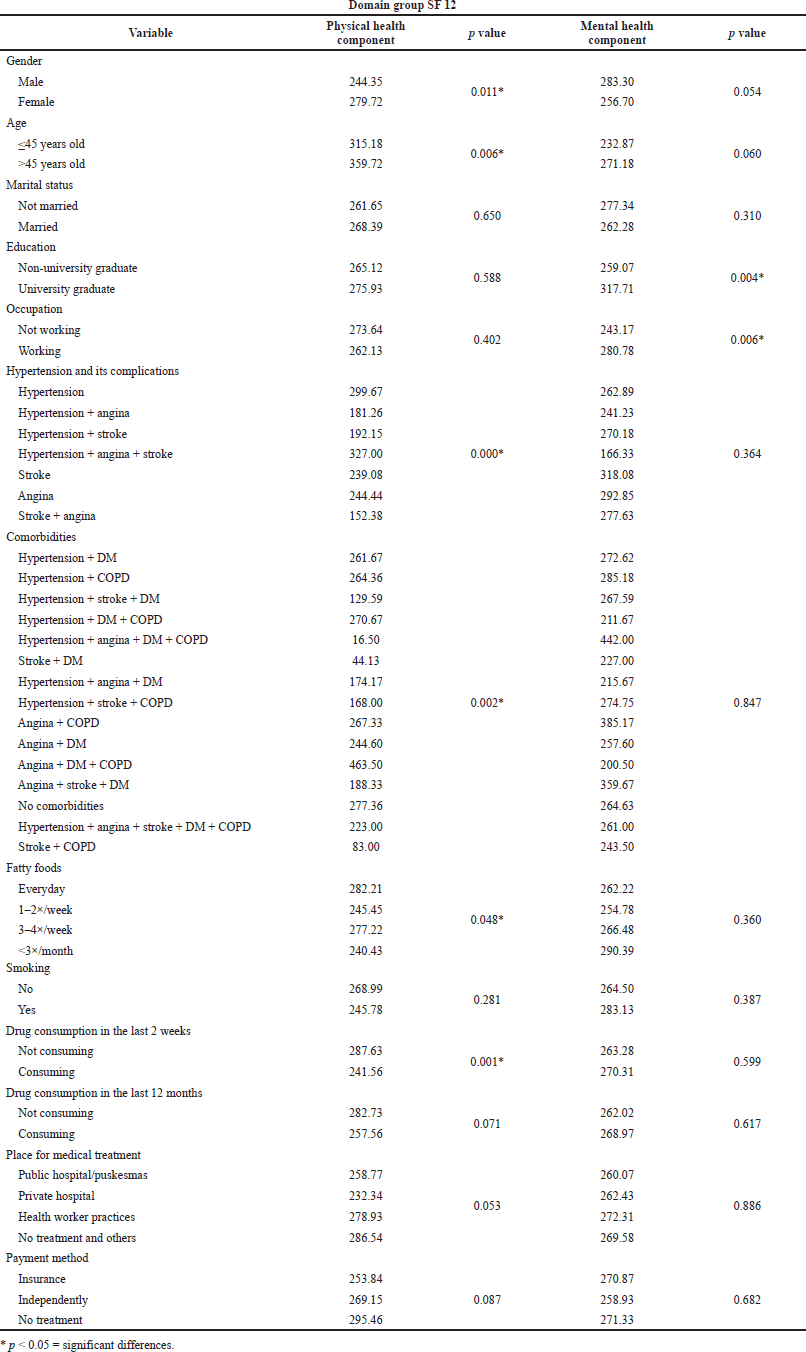 | Table 3. The results of multivariate analysis on the factors of dem ography, comorbidity, lifestyle, medication, and access to health services to the physical and mental health components. [Click here to view] |
Comorbidities such as DM and Chronic Obstructive Pulmonary Disease (COPD) affect the physical components. Various factors contribute to the incidence of hypertension, one of which is DM. A type 2 DM obese patient often experiences hypertension since hypertension can result in cell insensitivity to insulin. Insulin regulates the metabolism of carbohydrates by increasing the glucose uptake in the cells to disturb the level of blood sugar.
The consumption of fatty food affects the summary of the physical components. The consumption of fatty food is one of the risk factors in hypertension that can be controlled, including lifestyle and behaviors such as lack of physical activities, obesity, food consumption, and stress (Wang et al., 2010). A blocked blood vessel may result from the high levels of fats in the blood so that it can affect or interfere with the cardiovascular system. Fats can indirectly lead to hypertension which may, in turn, lead to cardiovascular disease. Moreover, heart attacks and strokes may result from increased body weight and an increased level of cholesterols. Accordingly, if a patient with hypertension experiences complications of strokes and heart attacks, their quality of life will be worse. Moreover, those symptoms and the impacts of the disease may reduce one’s socialization activities with the environment and their mental health (Wagenseil et al., 2009; Wang et al., 2010; Wenger et al., 2018).
Medical treatment received for the past 2 weeks affected the summary of the physical components. This result was comparable to the previous study conducted by Karuniawati and Supadmi (2016). They found a relation between one’s quality of life and their adherence to medication taking. The adherence to routine medication taking affects one’s physical activities affecting the duration of hypertension. Therefore, the better the patient’s compliance, the greater the decrease and control of their blood pressure, improving their quality of life (Karuniawati and Supadmi, 2015).
The educational background affected the MCS. Therefore, this result was not comparable to the previous study conducted by Khoirunnisa and Akhmad (2019), stating that education did not significantly relate to the MCS scores with p = 0.14. Moreover, the result was also not by the previous study conducted by Xu et al. (2016), stating that a low level of education was associated with lower physical function and body ache scores. Hypertensive patients with a lower level of education have a worse condition with lower scores of physical function and body ache than those with a higher level of education (Xu et al., 2016). This study provided more effects on the hypertensive patients’ physical components than their mental components. However, in this study, education impacted the summary of the cognitive elements, probably due to their different social lives and expectations.
Occupational factors affected the MCS. However, this result was not by the previous study conducted by Xu et al. (2016), stating that those who suffered from hypertension were unemployed people who had better general health and had poorer social function than those who worked. It meant that the study had some effects on the summary of mental components, which was consistent with this study stating that the overview of mental parts affected both working and nonworking people since those who did not work had a lower socioeconomic status which would result in their poor quality of life.
CONCLUSION
The quality of life of hypertensive patients and their complications decreased more on physical conditions consisting of gender, age, diagnosis of hypertension and its complications, presence of comorbidities, fatty foods, and drug consumption during the last 2 weeks. Meanwhile, the mental condition of decreasing quality of life is influenced by education and work factors. Gender and age affect some factors, including hormonal, physiological, and functional changes in the body and perceptions. Those factors affect the quality of life of each individual. In addition, lifestyles such as consuming fatty foods and drugs during the last 2 weeks can affect blood vessels and blood pressure control, impacting the quality of life of people with hypertension and its complications. Self-awareness is necessary for people with hypertension and its complications when dealing with unhealthy lifestyle factors that can trigger hypertension. Lack of knowledge and education are factors worth considering when someone is trying to improve their quality of life.
CONFLICT OF INTEREST
The authors report no financial or any other conflicts of interest in this work.
FUNDING
There is no funding to report.
AUTHOR CONTRIBUTIONS
All authors made substantial contributions to conception and design, acquisition of data, or analysis and interpretation of data; took part in drafting the article or revising it critically for important intellectual content; agreed to submit to the current journal; gave final approval of the version to be published; and agree to be accountable for all aspects of the work. All the authors are eligible to be an author as per the international committee of medical journal editors (ICMJE) requirements/guidelines.
ETHICAL APPROVALS
This study does not involve experiments on animals or human subjects.
DATA AVAILABILITY
All data generated and analyzed are included within this research article.
PUBLISHER’S NOTE
This journal remains neutral with regard to jurisdictional claims in published institutional affiliation.
REFERENCES
Aghamolaei T, Tavafian SS, Zare S. Determinants of health related quality of life on people living in Bandar Abbas, Iran. Iran J Public Health, 2011; 40(3):128–35.
Alegría M, NeMoyer A, Falgàs Bagué I, Wang Y, Alvarez K. Social determinants of mental health: where we are and where we need to go. Curr Psychiatry Rep, 2018; 20(11):95; doi:10.1007/s11920-018-0969-9 CrossRef
Amanda D, Martini S. The relationship between demographical characteristic and central obesity with hypertension. Period J Epidemiol, 2018; 6(1):43; doi:10.20473/jbe.v6i12018.43-50 CrossRef
Benjamin EJ, Muntner P, Alonso A, Bittencourt MS, Callaway CW, Carson AP, Chamberlain AM, Chang AR, Cheng S, Das SR, Delling FN, Djousse L, Elkind MSV, Ferguson JF, Fornage M, Jordan LC, Khan SS, Kissela BM, Knutson KL, Kwan TW, Lackland DT, Lewis TT, Lichtman JH, Longenecker CT, Loop MS, Lutsey PL, Martin SS, Matsushita K, Moran AE, Mussolino ME, O’Flaherty M, Pandey A, Perak AM, Rosamond WD, Roth GA, Sampson UKA, Satou GM, Schroeder EB, Shah SH, Spartano NL, Stokes A, Tirschwell DL, Tsao CW, Turakhia MP, VanWagner LB, Wilkins JT, Wong SS, Virani SS. Heart disease and stroke statistics 2014;2019 update: a report from the American Heart Association. Circulation, 2019; 139(10):e56–8; doi:10.1161/CIR.0000000000000659 CrossRef
Brook CA, Schmidt LA. Social anxiety disorder: a review of environmental risk factors. Neuropsychiatr Dis Treat, 2008; 4(1):123–43; doi:10.2147/ndt.s1799 CrossRef
Buford TW. Hypertension and aging. Ageing Res Rev, 2016; 26:96–111; doi:10.1016/j.arr.2016.01.007 CrossRef
Buttar HS, Li T, Ravi N. Prevention of cardiovascular diseases: role of exercise, dietary interventions, obesity and smoking cessation. Exp Clin Cardiol, 2005; 10(4):229–49.
Carr AJ, Gibson B, Robinson PG. Measuring quality of life: is quality of life determined by expectations or experience? BMJ, 2001; 322(7296):1240–3; doi:10.1136/bmj.322.7296.1240 CrossRef
Demarin V, Lisak M, Morovi? S, Cengi? T. Low high-density lipoprotein cholesterol as the possible risk factor for stroke. Acta Clin Croat, 2010; 49(4):429–39.
Depkes RI. Main results of basic health research 2018. Ministry of Health of the Republic of Indonesia, Jakarta, Indonesia, 2018.
Depkes RI. Yogyakarta special region health profile 2019. 2019. Available via file:///C:/Users/Asus/Downloads/Buku%20Profil%20Kesehatan%20DIY%20Th%202019%20(1).pdf
Depkes RI. Sleman district health profile 2020. 2020. Available via https://dinkes.slemankab.go.id/wp-content/uploads/2020/09/Profil-Dinkes-2020.pdf
DiPiro JT, Wells BG, Schwinghammer TL, DiPiro CV. Pharmacotherapy handbook. 9th edition, McGraw-Hill Education Companies, New York, NY, 2015.
Gorski MT, Roberto CA. Public health policies to encourage healthy eating habits: recent perspectives. J Healthc Leadersh, 2015; 7:81–90; doi:10.2147/jhl.S69188 CrossRef
Haris RNH, Makmur R, Andayani TM, Kristina SA. The psychometric property assessment of quality of life instrument (HRQol) in general population: a systematic review. J Manage Pharm Pract, 2019; 9(2):65–75; doi:10.22146/jmpf.41911 CrossRef
Karuniawati E, Supadmi W. Drug compliance and quality of life of hemodialysis patients at PKU Muhammadiyah Hospital Yogyakarta, March 2015 Period. J Pharm Sci Community, 2015; 13(02):73–80; doi:10.24071/jpsc.2016.130205 CrossRef
Khoirunnisa SM, Akhmad AD. Quality of life of patients with hypertension in primary health care in Bandar Lampung. Indones J Pharm, 2019; 30(4):309–15; doi:10.14499/indonesianjpharm30iss4pp309 CrossRef
Kim SH, Jo MW, Ahn J, Ock M, Shin S, Park J. Assessment of psychometric properties of the Korean SF-12 v2 in the general population. BMC Public Health, 2014; 14:1086; doi:10.1186/1471-2458-14-1086 CrossRef
Lalande S, Johnson BD. Diastolic dysfunction: a link between hypertension and heart failure. Drugs Today (Barc), 2008; 44(7):503–13; doi:10.1358/dot.2008.44.7.1221662 CrossRef
Lee KH, Xu H, Wu B. Gender differences in quality of life among community-dwelling older adults in low- and middle-income countries: results from the Study on global AGEing and adult health (SAGE). BMC Public Health, 2020; 20(1):114; doi:10.1186/s12889-020-8212-0 CrossRef
Louzado JA, Lopes Cortes M, Galvão Oliveira M, Moraes Bezerra V, Mistro S, Souto de Medeiros D, Arruda Soares D, Oliveira Silva K, Nicolaevna Kochergin C, Honorato Dos Santos de Carvalho VC, Wildes Amorim W, Serrate Mengue S. Gender differences in the quality of life of formal workers. Int J Environ Res Public Health, 2021; 18(11):5951; doi:10.3390/ijerph18115951 CrossRef
Perwitasari DA, Susilo R, Supadmi W, Kaptein AA. Adherence and quality of life of hypertension patients in Gunung Jati Hospital Cirebon Indonesia. Indones J Clin Pharm, 2018; 4(4):289–98; doi:10.15416/ijcp.2015.4.4.289 CrossRef
Petrie JR, Guzik TJ, Touyz RM. Diabetes, hypertension, and cardiovascular disease: clinical insights and vascular mechanisms. Can J Cardiol, 2018; 34(5):575–84; doi:10.1016/j.cjca.2017.12.005 CrossRef
Riley M, Hernandez AK, Kuznia AL. High blood pressure in children and adolescents. Am Fam Physician, 2018; 98(8):486–94.
Sagita S, Budiman B, Nurjanah N. Factors associated with hypertension in the workplace evacuation area of Kamonji Public Health Center. J Collab Sci, 2019; 1(1):204–16.
Suhadi R, Hendra P, Wijoyo Y, Virginia DM, Setiawan CH. Characteristics of hypertension: increasing clinical competence for pharmaceutical services. Sanata Dharma University Press, Yogyakarta, 2016.
Tackling G, Borhade MB. Hypertensive heart disease. StatPearls, Treasure Island, FL, 2021 [Updated 2021 July 1]. Available via https://www.ncbi.nlm.nih.gov/books/NBK539800/
Vergeer M, Holleboom AG, Kastelein JJ, Kuivenhoven JA. The HDL hypothesis: does high-density lipoprotein protect from atherosclerosis? J Lipid Res, 2010; 51(8):2058–73; doi:10.1194/jlr.R001610 CrossRef
Virani SS, Alonso A, Benjamin EJ, Bittencourt MS, Callaway CW, Carson AP, Chamberlain A M, Chang AR, Cheng S, Delling FN, Djousse L, Elkind MSV, Ferguson JF, Fornage M, Khan SS, Kissela BM, Knutson KL, Kwan TW, Lackland DT, Lewis TT, Lichtman JH, Longenecker CT, Loop MS, Lutsey PL, Martin SS, Matsushita K, Moran AE, Mussolino ME, Perak AM, Rosamond WD, Roth GA, Sampson UKA, Satou GM, Schroeder EB, Shah SH, Shay CM, Spartano NL, Stokes A, Tirschwell DL, VanWagner LB, Tsao CW. Heart disease and stroke statistics-2020 update: a report from the American Heart Association. Circulation, 2020; 141(9):e139–596; doi:10.1161/CIR.0000000000000757 CrossRef
Wagenseil JE, Ciliberto CH, Knutsen RH, Levy MA, Kovacs A, Mecham RP. Reduced vessel elasticity alters cardiovascular structure and function in newborn mice. Circ Res, 2009; 104(10):1217–24; doi:10.1161/circresaha.108.192054 CrossRef
Wang L, Manson JE, Forman JP, Gaziano JM, Buring JE, Sesso, HD. Dietary fatty acids and the risk of hypertension in middle-aged and older women. Hypertension, 2010; 56(4):598–604; doi:10.1161/hypertensionaha.110.154187 CrossRef
Wenger NK, Arnold A, Bairey Merz CN, Cooper-DeHoff RM, Ferdinand KC, Fleg JL, Gulati M, Isiadinso I, Itchhaporia D, Light-McGroary K, Lindley KJ, Mieres JH, Rosser ML, Saade GR, Walsh MN, Pepine CJ. Hypertension across a woman’s life cycle. J Am Coll Cardiol, 2018; 71(16):1797–813; doi:10.1016/j.jacc.2018.02.033 CrossRef
Whelton PK, Carey RM, Aronow WS, Casey DE, Collins KJ, Dennison Himmelfarb C, DePalma SM, Gidding S, Jamerson KA, Jones DW, MacLaughlin EJ, Muntner P, Ovbiagele B, Smith SC, Spencer CC, Stafford RS, Taler SJ, Thomas RJ, Williams KA, Williamson JD, Wright JT. ACC/AHA/AAPA/ABC/ACPM/AGS/APhA/ASH/ASPC/NMA/PCNA Guideline for the prevention, detection, evaluation, and management of high blood pressure in adults: executive summary: a report of the American College of Cardiology/American Heart Association Task Force on Clinical Practice Guidelines. J Am Coll Cardiol, 2018; 71(19):2199–269; doi:10.1016/j.jacc.2017.11.005 CrossRef
Xu X, Rao Y, Shi Z, Liu L, Chen C, Zhao Y. Hypertension impact on health-related quality of life: a cross-sectional survey among middle-aged adults in Chongqing, China. Int J Hypertens, 2016; 2016:7404957; doi:10.1155/2016/7404957 CrossRef